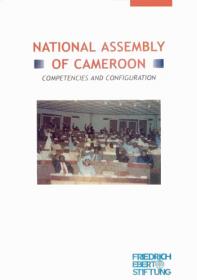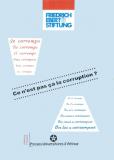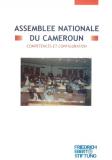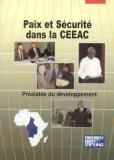Envoyez nous votre commande
Vous êtes ici

National Assembly of Cameroon Competencies and Configuration
The parliamentary institution in Cameroon has been marked by continuous adaptation in response to political developments in the country. Cameroon, it will be recalled, was colonized by Germany before it was placed under French and British mandate with the League of Nations and, subsequently, under the United Nations trusteeship. It obtained independence on 1st January 1960.
| Détails sur le livre | |
|---|---|
| Auteur | Amadou NCHOUWAT, Julienne TSANGUEU-SEPPOU, Pauline Colette NGOUTANE, Boukar, MAHAMAT, Mama NJOYA |
| ISBN | 9956-444-06-5 |
| Nombre de pages de la version papier | 180 pages |
| Format | 145 x 205 mm |
| Date de publication | 2005 |
| Editeur | Presses universitaires d'Afrique |
| Langue | Français |
The parliamentary institution in Cameroon has been marked by continuous adaptation in response to political developments in the country. Cameroon, it will be recalled, was colonized by Germany before it was placed under French and British mandate with the League of Nations and, subsequently, under the United Nations trusteeship. It obtained independence on 1st January 1960.
The first leaders of independent Cameroon settled for a federal dispensation with two federated entities, East Cameroon (the French speaking part of the Country formerly under French administration and West Cameroon (the English speaking part formerly under British rule).
Preface
Foreword
General introduction
Introductory chapter
Paragraph 1: What is the National Assembly?
Paragraph 2: Membership
A. Eligibility Requirements
B. Mode of Ballot
C. Loss of Parliamentary Mandate
Paragraph 3: Protection of parliamentary mandate
A. Incompatibilities
B. Parliamentary Immunities
1. Non Liability
2. Inviolability
3. Parliamentary allowance
C. Characteristics of the Parliamentary Mandate
1.The Mandate if General
2.The Mandate is Final
3.The Mandate is Irrevocable
4.The Mandate is Free
Parti : Spheres of competence of the National Assembly
Chapter I : The National Assembly and the legislative function
Paragraph 1 : Precautions to be taken by the MP
A. Respect of the Domain of the law
B. Respect of the Supremacy of the Constitution
C.Text PresentationandTablingattheNational Assembly
Paragraph 2 : The chairmen’s conference: decides in the first instance on the admissibility of texts
Paragraph 3 : Constitutional council: final decision on admissibility of texts
A. Authorities Competent to refer matters to the Constitutional Council
B. Matters that can be referred to the Constitutional Council 40 Paragraph 4: Parliamentary committees: compulsory stopover.
A. Designation and Membership of General Committees
B. Organization of Committees
C. Committee meetings
Paragraph 5 : Agenda of the National Assembly
A. Who draws up the agenda: The chairmen’s conference
B. Agenda: items
C. Modification of the Agenda
Paragraph 6: Organization and conduct of debates
A. Public Nature of Deliberations
B. Streamlining Discussions
C. Validity of Deliberations
Paragraph 7: Discussion and adoption ofbills in plenary sitting
A. Discussion stages
B. Adoption of texts
Paragraph 8: Enactment oflaws voted by the national assembly
A. Enactment by the President of the Republic
B. Enactment by the President of the National Assembly
Chapter II : The National Assembly and control of government action
Paragraph 1 : Information sources and control mechanism
A. Government declaration
B. Written and Oral Questions
1. Written questions
2. Oral Questions
C. Parliamentary Commissions of enquiry
1. Setting up a commission of enquiry
2. Powers of the commission of enquiry
D. Petitions
Paragraph 2: Questioning the responsibility of the government by the National Assembly
A. Procedures for questioning the responsibility of the government
1. Isolated implementation of two procedures
2. Simultaneous implementation of the two procedures. .
B. Consequence of the vote of no confidence and motion of censure
Conclusion
Part II : Configuration of the National Assembly
Introduction
Chapter I : Configuration of the entire house
Paragraph 1 : Gender representation in the National Assembly.
A. Very low and varied female representation
B. Suggestions for a better representation of women
1. Internal measures
2. External measures
Paragraph 2: Representation according to age group
Paragraph 3 : Rate of renewal of members ofparliament
A. Lessons from this table
B. Suggestions
Paragraph 4: National and local representation
A. Holders of local and national office
B. Double consequences of holding two offices
Chapter II: Configuration of the organs of the assembly
Introduction
Paragraph 1: Distribution of duty posts in the National Assembly
A.Bureau oftheNational Assembly
1. Roles of members of the Bureau
1) The President
2) Vice Presidents
3) Secretaries
4) Questors
2. Points to remember
B. Chairmen’s conference
C. Committees
D.Parliamentary groups
1. The legal basis for the group
2. Parliamentary groups
3. Prerogatives and Missions of the Group
Paragraph 2: Factors that hinder women from acceding to duty posts
1. The status ofthe woman in the Cameroonian society.
2. Reluctance of political parties to nominate women
3. Positioning of women in the lists of candidates
a. Lack pf political culture
4. Unequal economic status
5. Weak lobby groups and lack of mentors
6. Selfishness of men
7. Lack of political will
Paragraph 3: Beyond power, development that would likely be beneficial to the greatest number
General conclusion
Appendix
Bibliography














